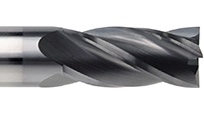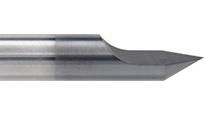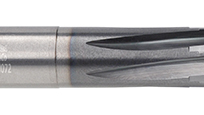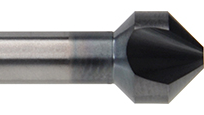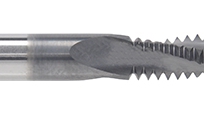What is the difference between a rough end mill and a finish end mill?
Perfect for Slotting and High-Speed Cutting
End Mill - Drill - Reamer
We are proud to offer the products listed in our catalogue. To help our customers experience first-hand the quality and reliability of our tools, we invite you to review our catalogue and request samples. This initiative reflects our confidence in the superior performance of our products and our commitment to customer satisfaction.
The main difference between a roughing end mill and a finishing end mill lies in their design and purpose:
1. Roughing End Mill
- Purpose: Used to remove large amounts of material quickly and efficiently.
- Design Features:
- Multiple Flutes (typically 3-6 or more) to maximize chip removal.
- Thicker Cutting Edges: The edges are designed to be more robust, allowing them to withstand the heavy load and forces of aggressive cutting.
- Serrated or Chip Breaker Geometry: Many roughing end mills have a tooth-like pattern or chip breakerto help break up large chips and reduce heat buildup.
- Coarse Surface Finish: Produces a rougher surface compared to finishing end mills.
- Material Removal: Best for heavy cuts and rough stock removal, leaving behind an unrefined surface.
- Typical Use: First stage of machining when you need to remove a lot of material quickly before switching to a finishing tool.
2. Finishing End Mill
- Purpose: Used for finalizing the shape and creating a smooth, precise surface.
- Design Features:
- Finer Teeth or Flutes: Typically 2-4 flutes for smoother cuts.
- Sharper Cutting Edges: Designed for finer, more detailed cuts.
- No Chip Breaker: Finishing end mills tend to have cleaner, continuous cutting edges to provide a smooth finish.
- Fine Surface Finish: Produces a high-quality surface with little to no visible tool marks.
- Material Removal: Removes less material at a slower rate, but achieves a high-quality finish.
- Typical Use: The final step in machining for achieving tight tolerances, smooth surfaces, and detailed features.
Key Differences in Summary
| Feature | Roughing End Mill | Finishing End Mill |
|---|---|---|
| Purpose | Rapid material removal | Final surface finish |
| Flute Count | More flutes (3-6+) | Fewer flutes (2-4) |
| Cutting Edge | Thicker and more robust | Sharper and finer |
| Finish Quality | Rough, unrefined | Smooth, precise |
| Speed/Feed | Higher speeds and feeds for rough cuts | Lower speeds and feeds for fine finish |
| Use Case | Rough stock removal | Final pass for detail and finish |
When to Use Each
- Roughing End Mills: Ideal for bulk material removal in the first stage of machining.
- Finishing End Mills: Use when precise geometry and a smooth surface are required.
At Industrial-Tools, we provide the finest CNC tools available to help you streamline your production and achieve flawless results every time.
Browse our extensive selection of CNC tools today and get the best quality tools for your machining needs.
Contact us for more information on our products and how they can benefit your business.
